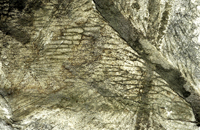Scott’s Glossopteris specimen
In this video Dr Paul Kenrick, a palaeontologist at the Natural History Museum, reveals a plant fossil that is very important to science. It was collected in 1912 by Captain Scott’s Polar Party on their final expedition to Antarctica.
The Glossopteris indica specimen, now cared for in the Museum’s collections, helped provide evidence that Antarctica had once been part of the ancient supercontinent Gondwana.
Why is Scott’s Glossopteris specimen important?

Fossilised leaf of Glossopteris indica collected by Scott’s polar party.
Glossopteris indica, which has feather-like leaves and a pronounced mid-rib, is an extinct seed-bearing shrub or tree from the Southern Hemisphere. It existed around 300-250 million years ago.
Robert Falcon Scott and his team were the first people to find evidence of this plant in mainland Antarctica, and several Glossopteris fossils were recovered near their bodies after the ill-fated Terra Nova expedition.
The plant fossil that the party collected wasn’t well preserved and, although Scott and his team realised it was a fossilised plant, they didn’t recognise its real significance at the time. It was only when the specimen was later studied that its identity was revealed.
Glossopteris has now been found in all of the Southern Hemisphere continents, providing strong evidence that they were once amalgamated into the supercontinent Gondwana, which existed hundreds of millions of years ago. So Scott’s specimen has played an important role in helping us understand how the modern Earth formed.
Fossilised plants like Glossopteris also show that the climate of Antarctica was very different in the past.
One of many specimens collected by Scott’s party
When the Terra Nova returned from Antarctica she carried thousands of zoological and geological specimens, now part of the scientific collections at the Natural History Museum and Canterbury Museum, New Zealand. Scientists use these in their research today and will for many years to come, increasing our ever-growing knowledge of Antarctica.
